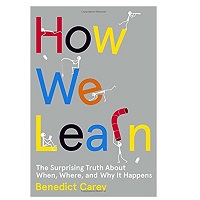How We Learn EPUB & PDF – eBook Details Online
- Status: Available for Free Download
- Author: Benedict Carey
- Publish Date: September 9, 2014
- Language: English
- Genre: Self-Development
- Format: PDF / EPUB
- Size: 3.36 MB
- Pages: 272
- Price: Free
The Story Maker
The Biology of Memory
The science of learning is, at bottom, a study of the mental muscle doing
the work—the living brain—and how it manages the streaming sights,
sounds, and scents of daily life. That it does so at all is miracle enough.
That it does so routinely is beyond extraordinary.
Think of the waves of information rushing in every waking moment,
the hiss of the kettle, the flicker of movement in the hall, the twinge of
back pain, the tang of smoke. Then add the demands of a typical layer of
multitasking—say, preparing a meal while monitoring a preschooler,
periodically returning work emails, and picking up the phone to catch
up with a friend.
Insane.
The machine that can do all that at once is more than merely complex.
It’s a cauldron of activity. It’s churning like a kicked beehive.
Consider several numbers. The average human brain contains 100
billion neurons, the cells that make up its gray matter. Most of these
cells link to thousands of other neurons, forming a universe of
intertwining networks that communicate in a ceaseless, silent electrical
storm with a storage capacity, in digital terms, of a million gigabytes.
That’s enough to hold three million TV shows. This biological machine
hums along even when it’s “at rest,” staring blankly at the bird feeder or
some island daydream, using about 90 percent of the energy it burns
while doing a crossword puzzle. Parts of the brain are highly active
during sleep, too.
The brain is a dark, mostly featureless planet, and it helps to have a
map. A simple one will do, to start. The sketch below shows several
areas that are central to learning: the entorhinal cortex, which acts as a
kind of filter for incoming information; the hippocampus, where memory
formation begins; and the neocortex, where conscious memories are
stored once they’re flagged as keepers.
This diagram is more than a snapshot. It hints at how the brain
operates. The brain has modules, specialized components that divide the
labor. The entorhinal cortex does one thing, and the hippocampus does
another. The right hemisphere performs different functions from the left
one. There are dedicated sensory areas, too, processing what you see,
hear, and feel. Each does its own job and together they generate a
coherent whole, a continually updating record of past, present, and
possible future.
In a way, the brain’s modules are like specialists in a movie
production crew. The cinematographer is framing shots, zooming in
tight, dropping back, stockpiling footage. The sound engineer is
recording, fiddling with volume, filtering background noise.
There are
editors and writers, a graphics person, a prop stylist, a composer
working to supply tone, feeling—the emotional content—as well as
someone keeping the books, tracking invoices, the facts and figures. And
there’s a director, deciding which pieces go where, braiding all these
elements together to tell a story that holds up.
Not just any story, of
course, but the one that best explains the “material” pouring through the
senses. The brain interprets scenes in the instants after they happen,
For More Read Download This Book
EPUB



